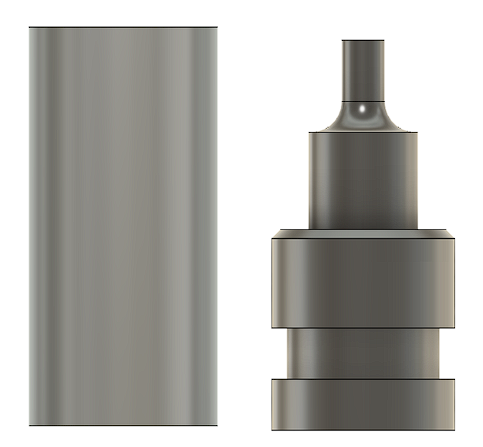CNC turning – profile finishing
In this learning path we will learn about finishing operation in CNC turning.
First step in CNC machining is analysing desired final product and determining proper order of neccesary steps and operations which must be taken to achieve desired result. By looking at this picture try to make a list of operations needed to get to desired shape of final product.

Read the text explaining the process of finishing for CNC turning.
Finishing in CNC turning is the crucial stage where the final dimensions, surface quality, and accuracy of the workpiece are achieved.
- Workpiece Preparation: The workpiece, having undergone roughing operations, is securely mounted in the chuck or collet of the CNC lathe. It’s positioned to allow access to the areas requiring finishing.
- Tool Selection: Finishing tools are chosen based on the specific requirements of the workpiece material and the desired surface finish. Typically, these tools have sharp edges and fine geometries, often made from carbide, ceramic, or high-speed steel.
- Tool Path Programming: Using CAM (Computer-Aided Manufacturing) software, a finishing toolpath is programmed. This toolpath dictates the precise movements of the cutting tool across the surface of the workpiece to achieve the desired final shape and dimensions. Finishing toolpaths are designed for accuracy and surface quality, involving lighter cuts and finer movements compared to roughing operations.
- Setting Cutting Parameters: The CNC operator configures cutting parameters such as cutting speed, feed rate, depth of cut, and tool engagement. These parameters are optimized based on the workpiece material, tooling, and desired surface finish. Fine-tuning these settings is crucial to achieving the desired surface quality without compromising dimensional accuracy or causing tool wear.
- Execution: The CNC machine is programmed with the finishing toolpath and cutting parameters. It then automatically guides the cutting tool across the workpiece surface, incrementally removing small amounts of material with each pass. The tool follow the programmed toolpath to achieve the desired surface finish and dimensional accuracy.
- Chip Control: Effective chip control is essential during finishing operations to prevent chip buildup, which can affect surface finish quality. Cutting fluid or coolant is often used to lubricate the cutting process and aid in chip evacuation.
- Monitoring and Inspection: Operators closely monitor the finishing operation to ensure that the workpiece is being machined accurately and that the surface finish meets specifications. Periodic inspections may be performed using precision measurement tools to verify dimensional accuracy and surface finish quality.
- Final Inspection and Quality Control: Once finishing is complete, the workpiece undergoes final inspection to ensure it meets all dimensional and surface quality requirements. Any necessary adjustments or corrections are made before the workpiece is considered complete.
By meticulously following these steps, finishing in CNC turning enables the production of workpieces with precise dimensions, smooth surface finishes, and high-quality features, meeting the stringent demands of various industries and applications.
Analyse the video and answer following questions:
1. Have you noticed any errors in finishing operation? What are they?
2. Has the operation achieved shape of final product?
3. What other operations are required to finalise product?
4. What changes would you suggest to improve finishing operation?
Resource information